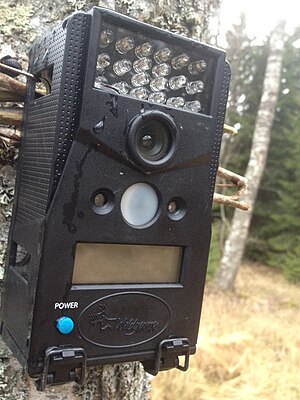
A remote camera, also known as a trail camera or game camera, is a camera placed by a photographer in areas where the photographer generally cannot be at the camera to snap the shutter. This includes areas with limited access, tight spaces where a person is not allowed, or just another angle so that the photographer can simultaneously take pictures of the same moment from different locations.
Remote cameras are most widely used in sports photography. 35 mm digital or film, and medium format cameras are the most common types of cameras that are used.
Uses and practices

Remote cameras are used by photographers to take more pictures from different angles. Remotes are very popular in sports and wildlife photography.
Cameras are often placed in angles that a photographer cannot physically be during a shoot. Sport use examples include behind the backboard at a basketball game or overhead in the rafters of an arena during a hockey game.
Placement
Remote cameras placed in suspended positions usually are mounted with clamps and arms such as the Bogen Super Clamp and Variable Friction Arm, often referred to as "Magic Arms". The camera and lens are connected to the variable friction arm which is attached to the Super Clamp which in turn is secured to a fixed item such as a basketball post, hand railing, or rafter. Ground plates or tripods are typically used for remote cameras placed on the ground.
Triggering
Remote cameras can be fired via hand triggers, sound triggers, radio transmitters (mainly Bluetooth shutters), a built-in self-timer, or a proximity sensor – in which case they are known as camera traps.
For remotes that are in close proximity to the photographer, hand or sound triggers can be used.
A hand trigger consists of a button or switch that is connected to the camera via a wire that is set to fire the camera's shutter.
For remotes that are placed away from the photographer, radio triggering systems such as the Bluetooth shutter button, Pocket Wizards or Flash Wizards are used. A radio trigger consists of a button or switch that is connected to a radio triggering transmitter or transceiver which is set to fire a radio triggering receiver or transceiver that is connected to the camera via a wire that is set to fire the camera's shutter.
For rocket launches, including the Space Shuttle, remote cameras are triggered by the sound of the launch.
Game camera
See also: Camera trap
A game camera is a rugged and weather-proof camera designed for extended and unsupervised use outdoors. The images they produce, taken automatically when motion is sensed, are used for game surveillance by hunters, farmers, ranchers and wildlife hobbyists and professionals.
These cameras are intended to be strapped on trees or mounted on tripods (or other items), and they are motion-activated. This motion sensor enables the camera to capture images or videos of animals without using up all of its storage space. However, lots of photos of waving plants and moving water can clog up memory cards.
These cameras have been instrumental in the rediscovery of multiple species once thought to be extinct or driven out of an area, such as with the black-naped pheasant-pigeon, and fishers in Washington state. They have also used by people endeavouring to take photographs of the non-existent creature Bigfoot (among other cryptids).
They can also be helpful for animal loss/rescue in documenting the presence and species of animals, such as determining whether a runaway dog is returning to its home at night or verifying the species actually eating the food left for a stray/feral cat.
See also
References
- Peter Read Miller (31 August 2013). Peter Read Miller on Sports Photography: A Sports Illustrated photographer's tips, tricks, and tales on shooting football, the Olympics, and portraits of athletes. p. 140. ISBN 978-0133087079. Retrieved 1 March 2015.
- O'Connell, Allan F.; Nichols, James D.; Karanth, K. Ullas (2010-10-05). Camera Traps in Animal Ecology: Methods and Analyses. Springer Science & Business Media. p. 21. ISBN 9784431994954.
- Byrne, Robert J. (1968-01-01). Aerodynakic roughness criteria in aeolian sand transport.
- Busch, David D. (2006-12-18). Digital Photography All-in-One Desk Reference For Dummies. John Wiley & Sons. ISBN 9780470085998.
- Bigelow, Ron (2010-12-27). Comprehensive Guide to Mastering Digital Photography. Ron Bigelow Photography. ISBN 9780983225706.
- Rich, Jason R. (2015-04-08). My GoPro Hero Camera. Que Publishing. ISBN 9780134190815.
- "Lift Off! Covering the Launch of the Space Shuttle Discovery".
- "What Video Cameras do hunters use? - Just Tech Helps". 2023-01-16. Retrieved 2023-01-17.
- "Why Does My Trail Camera Takes Pictures of Nothing? Failing Camera or User Error". Exodus Outdoor Gear. 2020-05-06. Retrieved 2023-09-04.
- Kobilinsky, Dana (2022-11-21). "Watch: Rare bird recorded after 140 year-absence to science". The Wildlife Society. Retrieved 2023-09-04.
- "How a simple trail camera led to an epic wildlife discovery | Produced by Seattle Times Marketing". The Seattle Times. 2019-05-10. Retrieved 2023-09-04.
- "Bigfoot Field Researchers Organization". www.bfro.net. Retrieved 2017-04-10.
- $1,000,000 dollar Sasquatch photo challenge Field & Stream 05-29-08 Archived 2009-12-11 at the Wayback Machine
- "Feeding Stations and Wildlife Cameras – Missing Pet Partnership". www.missingpetpartnership.org. Retrieved 2017-04-10.